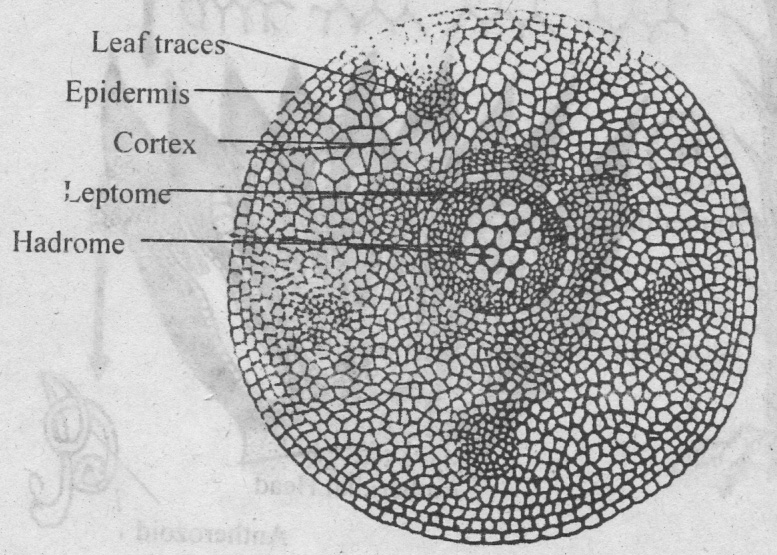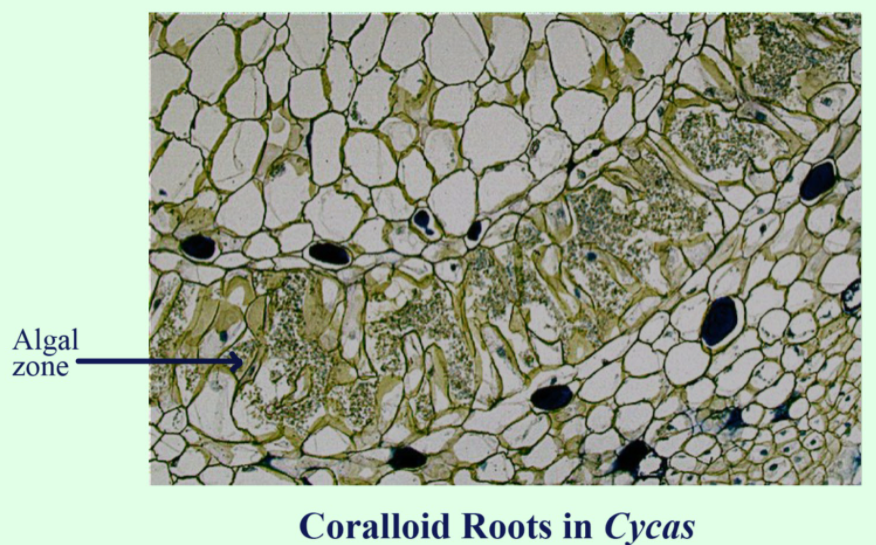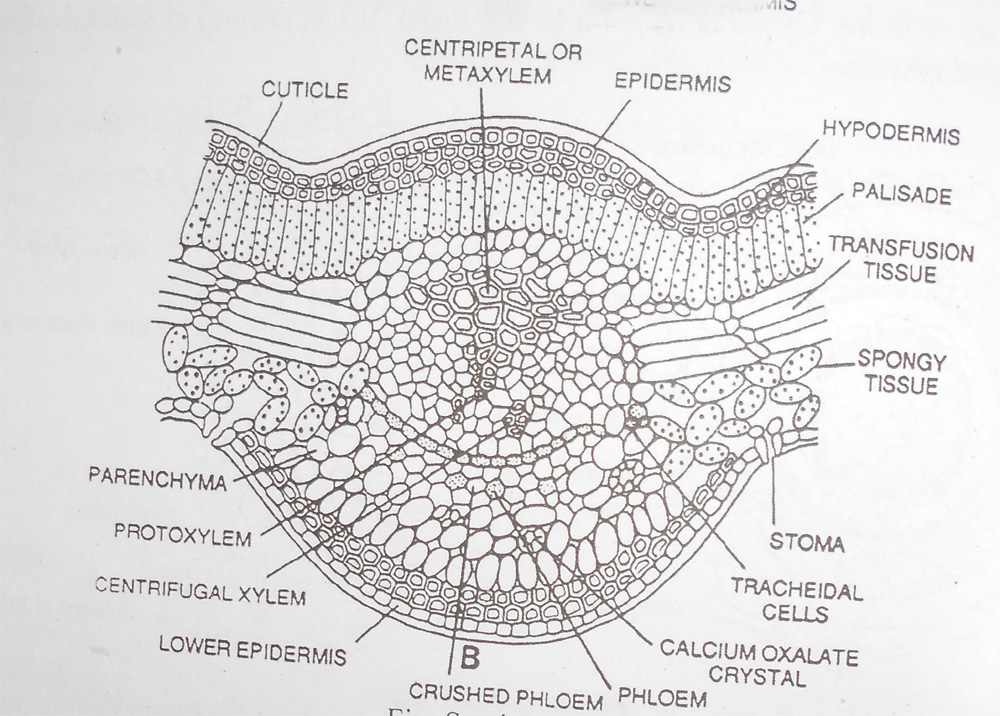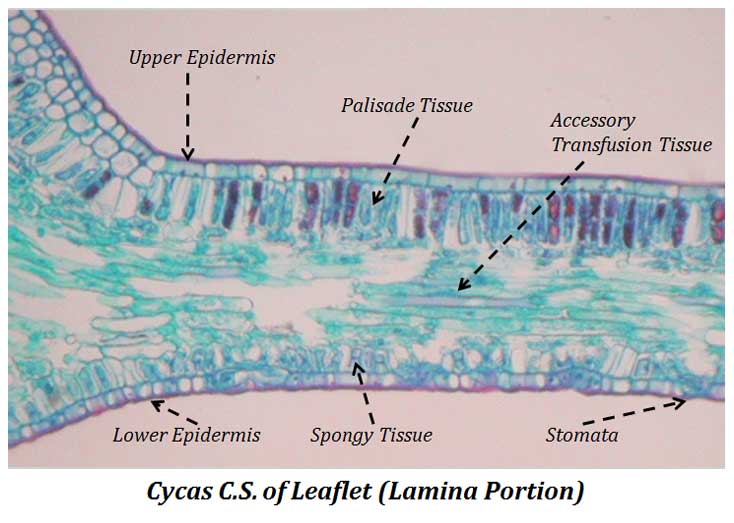
Cycas Anatomy in hindi/T.S. of Rachis of Cycas/ T.S. of pinna of Cycas/ For B.Sc., M.Sc., NEET
M.sc. Botany First Sem Practical of Cycas T.S of Leaflet

Cycas BOTANY III B.Sc I Year DoubtClear1.
Solution The correct option is D Sessile, straight and linear-lanceolate The correct option is D. Explanation for correct option: Cycas is a gymnosperm and it is the only living genus in the family Cycadaceae. They have leaflets in a compound leaf. Cycas leaflet is swollen in the midrib region.

Cycas Morhology Anatomy Life Cycle Living Fossil
1. Distribution of Cycas: Cycas, the largest genus among the Old World Cycads, is the most widely distributed genus of order Cycadales. It is distributed in Japan, Australia, India, Indochina, China, Mauritius, Africa, Nepal, Bangladesh, Sri Lanka and Myanmar.

Cycas sp. Anatomy of leaflet 1000 Study biology, Biology plants, Study notes
Leaflet of Cycas is characterized by conspicuous xerophytic features. An epidermis of thick-walled, highly cuticularized cells with sunken stomata, confined to the undersurface; 1-2 layered hypodermis of highly cutinized and lignified cells.

Roots in Cycas that contain symbiotic cyanobacteria for nitrogen fixation is known as……………..
76 5.7K views 1 year ago Practical Diagram Cycas : T. S of leaflet. T.S of cycas leaflet. Practical diagram. Cycas leaflet..more.more Cycas : T. S of leaflet. T.S of cycas.

Anatomy of Cycas Leaflet/T.S of Cycas Leaflet/Cycas Leaflet YouTube
External Features of Cycas: 1. Sporophytic plant body attains a height of 8 to 15 feet or more and appears like a small palm. 2. The plant body is differentiated into roots, stem and leaves (Fig. 1). 3. Roots are of two types: normal roots and coralloid roots. 4. Normal roots grow deep into the soil and are well- branched and positively geotropic.

cycas leaflet YouTube
Figure 7.1.1 7.1. 1: The first image is what might be considered a "typical" cycad. The leaves are long, tough, and pinnately compound with long, thin leaflets. Unlike a fern, the leaves look tough. The plant in the second image also shares these characteristics, yet it might not immediately stand out as a cycad.

Leaves II cycad Microscopic photography, Biology projects, Microscopic images
Cycas Coralloid Root Diagram. Ø These algae in the algal zone are symbiotic. Ø They help in nitrogen fixation. Ø The endodermis is single-layered and it separate stele from the cortex. Ø Pericycle multilayered and prominent. (3). Vascular Tissue. Ø Vascular tissue is located in the central region of the root.

T.s of cycas leaflet YouTube
Anatomy of Cycas Leaflet Ø Cycas leaflet is with distinct midrib and lateral wings. Mid-rib is swollen and the wings are flattened. Margins of the leaves are revolute (curved downward) in Cycas revoluta. Ø Anatomically, the leaf is differentiated into: § Upper Epidermis § Hypodermis § Mesophyll § Vascular Tissue § Lower Epidermis

Cycas Morhology Anatomy Life Cycle Living Fossil
About Press Copyright Contact us Creators Advertise Press Copyright Contact us Creators Advertise

Botanical world T.S. Of Cycas revoluta leaflet
280 Share 12K views 2 years ago Bsc Gymnosperm In this video describe about internal structure of cycas leaflet. #AnatomyofCycasLeaflet Show more Show more

Cycas Leaflet Diagram EasyBiologyClass
Ø The T.S. of the stem is irregular in outline due to the presence of persistent leaf bases and leaf scars. Ø Cortex very large and composed of loosely packed parenchymatous cells. Ø Vascular tissue consists of many vascular bundles arranged as a ring. Ø Each vascular bundle is open and endarch. Ø The Pith very large and parenchymatous.

Leaflet of Cycas YouTube
Figure 2.6.2.1.1 2.6.2.1. 1: Ginkgo leaves have a distinctive shape that has remained relatively unchanged from their fossil record: a fan-shaped leaf that is often deeply dissected in the center (the specific epithet biloba means two lobes). The fossil leaf on the right is around 60 million years old. First image: Ginkgo biloba leaves, photo.

T.S. of Leaflet of Cycas , Diagram Diagram, Leaflet, Outline
The Cycas is a unique genus of gymnosperms, belonging to the family Cycadaceae. It is the only living genus identified in this family. With over 100 different species, Cycas plants are primarily found in regions of eastern and southeastern Asia. A significant number of Cycas species are also native to countries such as China, Australia, and India.

Vd9 T.S of Coralloid root of Cycas YouTube
Complete answer: Internal structure of a cycas leaf can be differentiated into a swollen midrib portion and two lateral wings. The wings are curved downwards. The outermost layer of leaf consists of thick-walled epidermis surrounded by layers of cuticle.

Rekha's blog in Botany CycasT.S. of Rachis
The cilia are in 4 - 5 spirals. • The male gametes of Cycas are 180 - 210 μ in size and largest in the plant kingdom. • The pollen tube apex is ruptured and the male gametes are released into the archegonial chamber. • Presence of multiciliated male gametes is the fern character shown by Cycas male gametophyte.